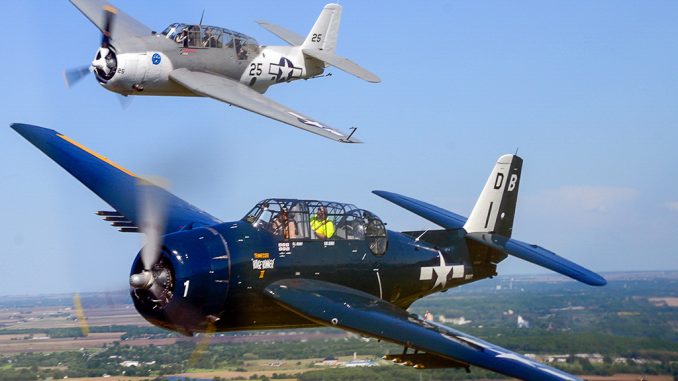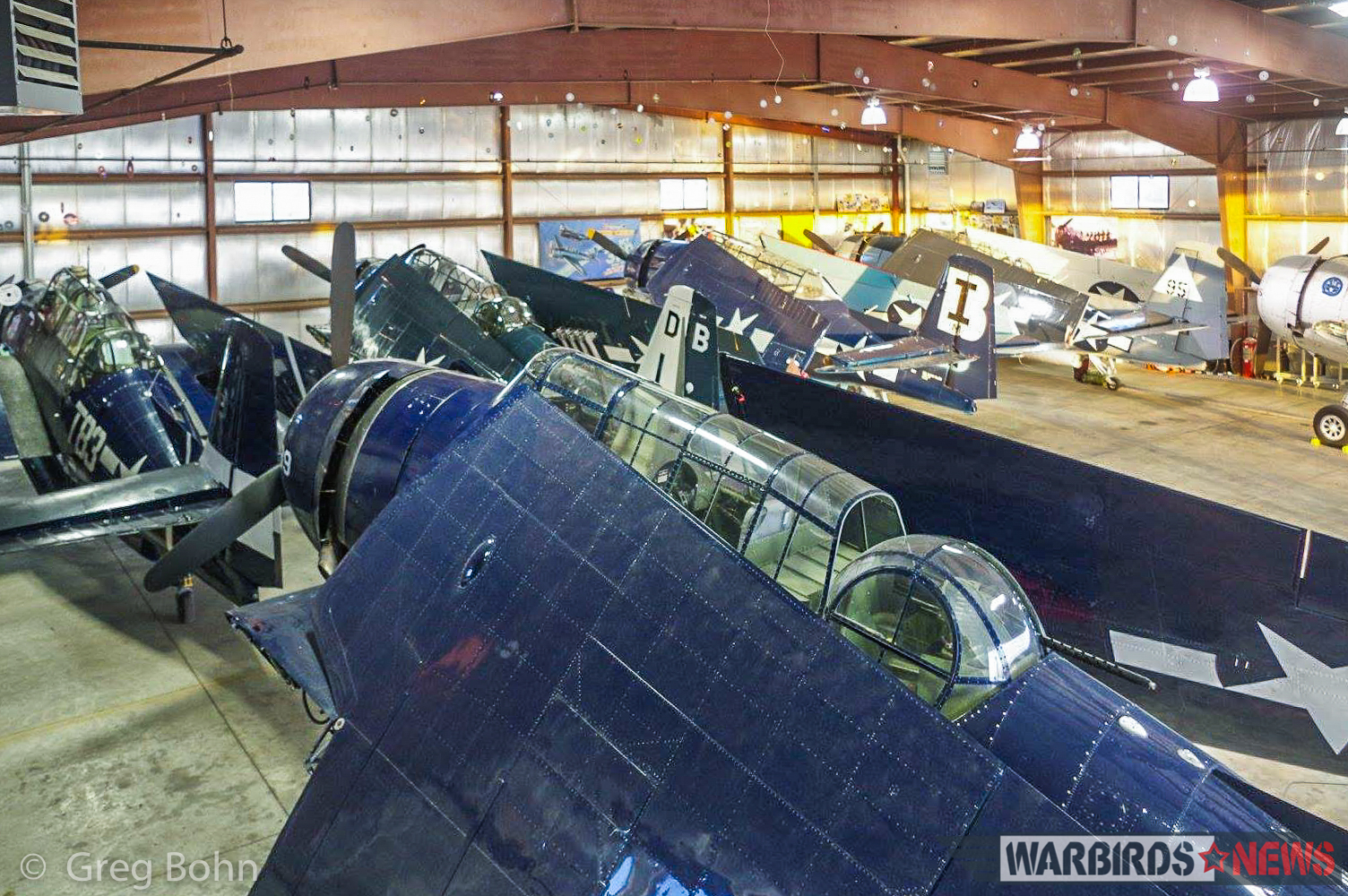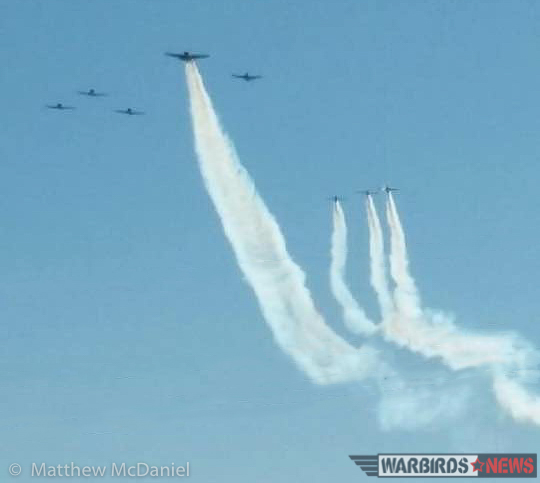

We feel sure our readers will thoroughly enjoy this pilot’s report on flying a dual-control, combat veteran TBM Avenger. Frequent contributor, Matthew McDaniel flies airliners for his day job, but has a considerable talent with the written word as well. We at WarbirdsNews really appreciate him writing this article for us! The flight took place in Brad Deckert’s beautiful TBM-3E Bu.85828 during the TBM Avenger Gathering in Peru, Illinois this past May. with Deckert in the pilot’s seat and McDaniel in the midsection cockpit, .

Turkey Wrestling: Flying the TBM Avenger (At the 2nd Annual Avenger Gathering)
Words By: Matthew McDaniel
Images By: Matthew McDaniel (except where noted)
Flying with the front canopy fully open, the noise and vibration were less than I’d imagined. In fact, the twin-row radial engine produced a low pitch rumble and airframe vibration that was pleasing to the senses. As we crossed the airport boundary in a shallow dive for a friendly fly past, the aroma of burning oil was unmistakable. I depressed the intercom button and inquired half-jokingly, “I assume the smoke is on and that we’re not on fire!” Brad laughed and replied, “You can tell, huh!” Indeed, I could. Along with the smell, there was a hint of smoke passing under the wings and a reflection of the haze trailing behind us in the Avenger’s huge greenhouse canopy. With a couple-G pull, we climbed and headed for the practice area, where I could sample for myself the flying qualities of the infamous Turkey.

Avengers Migrate to Peru
Peru, Illinois, that is. On the Thursday leading into the 2nd Annual TBM Gathering, organizer and TBM owner/pilot Brad Deckert and I discussed the amazing weather of the inaugural event, versus the damp and windy forecast for the coming weekend. Deckert commented, “It was critical that we have great weather and turnout in the FIRST year, to keep it going thereafter.” The 2016 event was bigger and better than anyone could have predicted. As a result, the City of Peru and several other sponsors embraced future versions, covering fuel and other costs. Sponsor Marquis Energy ensured the Gathering could grow while remaining free to all who wished to attend.

There are approximately 20 airworthy examples of the hulking Grumman Avenger torpedo-bomber in North America (all being TBM variants built by General Motors under a licensing agreement with Grumman). While about half of them (10) attended last year’s event, as many as 16 were slated to attend this year. Unfortunately, widespread volatile weather forced many to abandon their trek. In the end, 7 TBM’s completed the journey this year. They were joined by several other warbirds, including (but not limited to) many T-6/SNJ’s, T-34s, Stearmans, an F-86 Sabre, and even a MiG-17. While the challenging weather conditions kept most general aviation planes in their hangars and many spectators at home, it was far from a washout. About 4,000 people still came out to Illinois Valley Regional Airport (KVYS) to enjoy the show.

Three aged WWII Avenger crewmen received commemorative medals and special recognition of their service. The eldest, Virgil Bloomquist (age 96), took flight in an Avenger for the first time since serving as a TBM Radioman & Gunner over seven decades earlier! Had that been the only noteworthy moment of the Gathering, most anyone would consider it a roaring success. Fortunately, many other vets attended (and were honored), the TBM’s and other warbirds did fly during several friendly-weather windows, and the spirit of the event soared even when the rains poured.


Visually speaking, Deckert’s TBM is one of the most militarily accurate Avengers flying today. In addition to the period drop tanks, the former Marine workhorse carries under wing rockets, a radar pod, and a replica torpedo with original arming equipment within the bomb bay. Original radios, radar & sonar equipment, an operable rear gun turret, and a functional glass-projection gun sight are also installed. Unlike any other airworthy Avenger though, this old warrior still bears multiple bullet holes, including one through a fuselage stringer near the pilot’s right hip. While it’s unknown when/where that battle damage was sustained, Deckert’s TBM is a proven combat veteran. Flying with Marine Torpedo Bomber Squadron VMTB-234 from the escort carrier USS Vella Gulf CVE 111, TBM Bu.85828 participated in the horrific campaign between April and June 1945 to capture the island of Okinawa.





Dual Controls
Grumman did not design the Avenger to have a co-pilot, although a few early TBF’s (as the Grumman-built variants were designated) had dual controls for training purposes. Combat aircraft, on the other hand, carried only a crew of three: a pilot, a rear-facing turret gunner (often also qualified as a radioman), and a bombardier/radio & radar operator/ventral gunner (seated in the aft belly compartment). The glazed fuselage section between the pilot and turret gunner housed a variety of bulky military hardware, dependent upon the plane’s specific mission. Most surviving Avengers now use this area for a passenger seat, though a few (including Deckert’s TBM-3E) have installed a second set of primary flight controls, a throttle, and basic instruments to create a co-pilot’s position. Even with those modifications, many critical controls remain accessible to the pilot only. Therefore, before we began maneuvers, Deckert and I agreed on verbal commands to coordinate his manipulation of the secondary controls (that my co-pilot’s position lacked) with my handling of the primary flight controls.


Prior to taking the active runway, Brad announced that the trims were set for takeoff. He added, “If you try to takeoff in a TBM with the pitch trim still in the landing position, you’ll just roll off the end of the runway.” I had to take his word for it, as the trim controls and indicators are not visible from the co-pilot’s position. He also cautioned that the cowl flaps should be closed for takeoff, as the drag penalty from leaving them open increases the takeoff roll by a whopping 30%!

I was expecting a short takeoff roll, as the Avenger was, after all, designed as a carrier-based aircraft. Also, we were at least two tons below the max takeoff weight and had 15+ knots of headwind. However, to extend engine life and limit engine heating, we’d be restricting takeoff power to the maximum continuous setting of 41” Manifold Pressure (MAP). Military crews and civilian TBM air tanker pilots would have selected the maximum takeoff power of 46.5” MAP, because they needed all of the 1,900 horsepower available when operating from carriers or at maximum takeoff weights. While this reduced engine life, they weren’t the ones paying for cylinder replacements or engine overhauls! Given our light loading, 41” was plenty for our needs and we broke ground at 95 Knots Indicated Airspeed (KIAS), having used under 1,000 feet of runway. We climbed at 120 KIAS. In the practice area, Brad reset the power for a sedate 150 KIAS economy cruise, while the Wright R-2600’s 14-cylinders burned about 80 gallons of avgas per hour (GPH). That’s how Deckert typically cruises in order to get 3 hours endurance plus a healthy reserve (or roughly 450 nautical miles range) out of the 325 gallons the Avenger carries internally. But, the plane will happily cruise at 170 KIAS in exchange for 100 GPH. For a high speed cruise of 200 KIAS, the cost rises sharply to 150 GPH.

Trim: The Avenger Pilot’s Best Friend
Level turns in shallow bank angles were accomplished without adjusting pitch trim, but not without adding a good deal of back pressure on the stick to maintain altitude. Turns near 30° of bank required two arms-worth of strength to hold altitude. Steeper turns (30° to 60° of bank) would be nearly impossible, sans retrimming, for the average pilot to muscle through without descending.
Avengers are equipped with massive split-flaps. The disadvantages of split-style flaps are better understood today than during their design heyday of the 1930’s and early-40’s. While they are quite effective at increasing drag and allowing an increased descent rate without gaining airspeed, they do so without adding much lift, while also inducing the largest pitch change among common flap types. To demonstrate the point, Brad extended the flaps to their full 40° deflection as I struggled to offset the resultant pitch change with manual elevator input alone. Within seconds, I could no longer push hard enough – even with two hands – to prevent a dangerously nose-high attitude from developing. It became immediately obvious that trim needs for the Avenger must be anticipated and applied without hesitation. Failure to do so encourages a pilot’s natural reaction to over-power first and then trim away the control pressure. But in the Avenger, this quickly demands two hands on the control stick, leaving none free to adjust trim.
Gear extension and small speed changes (5 to 10 KIAS) create minor pitch changes that can be countered easily enough with manual control inputs. However, the big torpedo-bomber’s controls are so heavy that you wouldn’t want to hold even those small changes for any length of time without retrimming to relieve control pressures. I can only image the control forces wartime Avenger pilots wrestled with when approaching, or exceeding, the aircraft’s limit speed (315 KIAS at light weights) as many have stated was common during dives and evasive combat maneuvers.
An Overloaded Grain Truck
It has been said that flying an Avenger feels like driving an overloaded grain truck through a muddy field without power steering! While a bit melodramatic, it’s an analogy that’s not entirely inaccurate. Bear in mind, the TBF Avenger was designed before hydraulically boosted controls became common. It also lacked control tabs for aerodynamic control boost. Heavy-handed aircraft were common at the time, especially in powerful military applications. Yet, if the TBF/M controls are heavy in pitch and roll, they are positively Herculean in yaw. Staying ahead of yaw trim is probably less critical than anticipating pitch or roll trim needs, but is no less important for long-duration control inputs. Simply pushing a rudder pedal at cruise speeds to coordinate the aircraft just isn’t possible without asking some leg muscles to wake up. Should that rudder pressure need to be held, it would set your leg quivering with exhaustion in short order were the yaw trim not adjusted to compensate. Looking at the massive bulk of an Avenger, one cannot help but think “heavy,” along with a half-dozen other synonyms. It is an 18,000 pound, single-engine aircraft, towering 16 feet above the apron. So, why should it come as any surprise that it flies just like it looks?
In Full Uniform with Smoke On
All too soon we were headed back to KVYS, where 3 other TBM’s had already arrived for the Gathering. The arrival of such imposing metallic birds does not go unnoticed in a small Illinois farming community and spectators were already claiming the benches outside the FBO. Deckert told me to make another flyby for them and I asked him for trim adjustments as our speed increased inbound. Crossing the runway threshold, I again smelled oil burning, just as Brad announced, “Smoke on.”

The smoke oil is conveniently concealed within the two, ultra-rare drop tanks mounted under the wing’s center section. Drop tanks are a scarce commodity and Deckert jokes, “There isn’t any such thing as a used drop tank! If it was used and emptied, it was dropped into the ocean.” After an extensive search, an unused set was located within Cindy Beck’s storage hangar in Wahpeton, ND. Her well-respected restoration company, Tri-State Aviation, was founded by her late husband, TBM and P-51 restoration specialist, and all-around warbird guru, Gerry Beck. Cindy recently sold Deckert her Tri-State’s stockpile of TBM parts and supplies. Those drop tanks not only add visual authenticity to this TBM, but they are also functional. They would have added roughly an hour’s endurance to a combat Avenger in WWII. Today they each store 58-gallons of smoke oil for air show performances. Currently, the smoke system is set up to burn at 4 gallons per minute. This produces prodigious amounts of smoke, yet the smoke oil is currently only plumbed through half of the TBM’s exhaust system, meaning that smoke output could be doubled should Deckert ever desire it.

After flying the length of VYS’s Runway 18, I pulled up, requested some nose-up trim, and set up for an overhead-360 approach for Runway 25 while Brad selected the smoke off. After the overhead break, Brad extended the Avenger’s robust landing gear, which can be lowered at speeds up to 200 KIAS, helping to slow the behemoth. Full flaps were extended below the 130 KIAS flap speed in one selection, to limit the required trim change to a single adjustment. The runway’s 4,000-foot length proved to be far more than the Turkey needed to return to its roost.
About The Author: Matthew McDaniel is a Master & Gold Seal CFII, ATP, MEI, AGI, & IGI and Platinum CSIP. In 27 years of flying, he has logged 17,000 hours total and over 5,500 hours of instruction-given. Currently, he flies the Airbus A-320 series for an international airline, holds 8 turbine aircraft type ratings, and has flown over 80 aircraft types. Matt is one of less than 20 instructors in the world to have earned the Master CFI designation for 8 consecutive two-year terms. He’s been a freelance aviation author since 2003. He can be reached at: matt@progaviation.com or 414-339-4990.
Copyright 2017, Matthew McDaniel. First publication rights granted WarbirdsNews. All other rights reserved by copyright holder.
WarbirdsNews wishes to thank Matthew McDaniel for his terrific report and our readers can all look forward to further work from him in the future. To see his past articles, including an air show report from last year’s TBM Gathering, please click HERE. Many thanks also to Jay Selman and Greg Bohn for use of their marvelous images in this article.


Great article! Let’s have more!